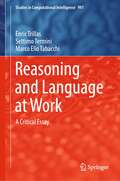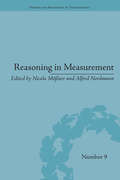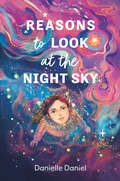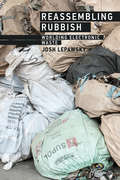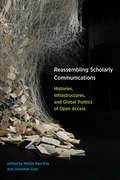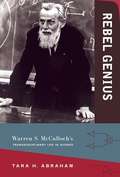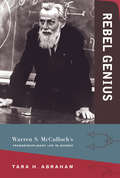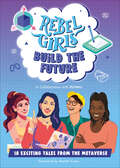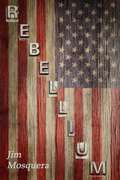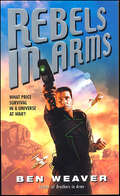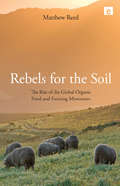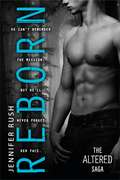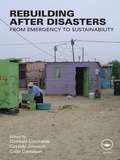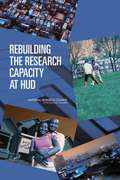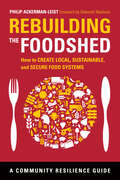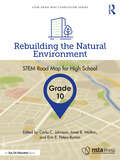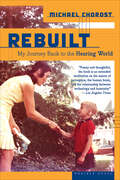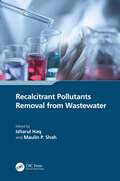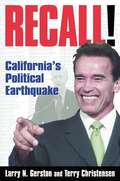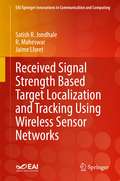- Table View
- List View
Reasoning and Language at Work: A Critical Essay (Studies in Computational Intelligence #991)
by Enric Trillas Settimo Termini Marco Elio TabacchiThis book furthers the historical and technical debate by looking at reasoning as the action of language when it is devoted to explaining or foretelling, based on the authors’ centennial combined experience in fuzzy logic. A simple logical model mixing abductions and deductions is introduced in order to attain speculations, conjectures that may be responsible for induction, and creativity in reasoning. A central point and a dire hypothesis of the book are that such process can be implemented by computation and as such can lead to a new approach to automatic thinking and reasoning. On top of the technical approach, the relationship between reasoning and thinking is also analyzed trying to establish links with notions and concepts of thinkers from the European Middle Age to the current days. This book is recommended to young researchers that are interested in either the scientific or philosophical aspects of computational thinking, and can further the debate between the two approaches.
Reasoning in Measurement (History and Philosophy of Technoscience)
by Nicola Mößner and Alfred NordmannThis collection offers a new understanding of the epistemology of measurement. The interdisciplinary volume explores how measurements are produced, for example, in astronomy and seismology, in studies of human sexuality and ecology, in brain imaging and intelligence testing. It considers photography as a measurement technology and Henry David Thoreau's poetic measures as closing the gap between mind and world. By focusing on measurements as the hard-won results of conceptual as well as technical operations, the authors of the book no longer presuppose that measurement is always and exclusively a means of representing some feature of a target object or entity. Measurement also provides knowledge about the degree to which things have been standardized or harmonized – it is an indicator of how closely human practices are attuned to each other and the world.
Reasons to Look at the Night Sky
by Danielle DanielA sensitive middle grade novel in verse about a space-obsessed girl who dreams of becoming an astronaut — and begins to see the world differently when a substitute teacher enters her orbit.Luna has always loved the night sky. She's an eleven-year-old who knows everything there is to know about space, and dreams of one day becoming an astronaut. The first step in her plan to get there is to ace the space unit in her science class and secure a spot in NASA's summer space camp.But when Luna's teacher is unexpectedly replaced with a substitute, Ms. Manitowabi, who is looking to shake up science class by bringing in art, Luna's carefully laid plans are crushed. And that's not all that's shifting in Luna's life — changes at home and in her friendships have her feeling topsy-turvy. What on Planet Earth is happening? Reasons to Look at the Night Sky is an endearing, poetic look at the inner world of a middle schooler grappling with change from acclaimed author and illustrator Danielle Daniel.
Reassembling Rubbish: Worlding Electronic Waste (The\mit Press Ser.)
by Josh LepawskyAn examination of the global trade and traffic in discarded electronics that reframes the question of the “right” thing to do with e-waste.The prevailing storyline about the problem of electronic waste frames e-waste as generated by consumers in developed countries and dumped on people and places in developing countries. In Reassembling Rubbish, Josh Lepawsky offers a different view. In an innovative analysis of the global trade and traffic in discarded electronics, Lepawsky reframes the question of the “right” thing to do with e-waste, mapping the complex flows of electronic materials. He counters the assumption that e-waste is a post-consumer problem, pointing out that waste occurs at all stages of electronic materials' existence, and calls attention to the under-researched world of reuse and repair.Lepawsky explains that there are conflicting legal distinctions between electronic waste and non-waste, and examines a legal case that illustrates the consequences. He shows that patterns of trade do not support the dominant narrative of e-waste dumping but rather represent the dynamic ecologies of repair, refurbishment, and materials recovery. He asks how we know waste, how we measure it, and how we construe it, and how this affects our efforts to mitigate it. We might not put so much faith in household recycling if we counted the more massive amounts of pre-consumer electronic waste as official e-waste. Lepawsky charts the “minescapes,” “productionscapes,” and “clickscapes” of electronics, and the uneven “discardscapes” they produce. Finally, he considers both conventional and unconventional e-waste solutions, including decriminalizing export for reuse, repair, and upgrade; enabling ethical trade in electronics reuse, repair, refurbishment, and recycling; implementing extended producer responsibility; and instituting robust forms of public oversight.
Reassembling Scholarly Communications: Histories, Infrastructures, and Global Politics of Open Access
by Martin Paul Eve and Jonathan GrayA range of perspectives on the complex political, philosophical, and pragmatic implications of opening research and scholarship through digital technologies.The Open Access Movement proposes to remove price and permission barriers for accessing peer-reviewed research work--to use the power of the internet to duplicate material at an infinitesimal cost-per-copy. In this volume, contributors show that open access does not exist in a technological vacuum; there are complex political, philosophical, and pragmatic implications for opening research through digital technologies. The contributors examine open access across spans of colonial legacies, knowledge frameworks, publics and politics, archives and digital preservation, infrastructures and platforms, and global communities.
Rebel Genius: Warren S. McCulloch's Transdisciplinary Life in Science
by Tara AbrahamWarren S. McCulloch (1898--1969) adopted many identities in his scientific life -- among them philosopher, poet, neurologist, neurophysiologist, neuropsychiatrist, collaborator, theorist, cybernetician, mentor, engineer. He was, writes Tara Abraham in this account of McCulloch's life and work, "an intellectual showman," and performed this part throughout his career. While McCulloch claimed a common thread in his work was the problem of mind and its relationship to the brain, there was much more to him than that. In Rebel Genius, Abraham uses McCulloch's life as a window on a past scientific age, showing the complex transformations that took place in American brain and mind science in the twentieth century -- particularly those surrounding the cybernetics movement.Abraham describes McCulloch's early work in neuropsychiatry, and his emerging identity as a neurophysiologist. She explores his transformative years at the Illinois Neuropsychiatric Institute and his work with Walter Pitts -- often seen as the first iteration of "artificial intelligence" but here described as stemming from the new tradition of mathematical treatments of biological problems. Abraham argues that McCulloch's dual identities as neuropsychiatrist and cybernetician are inseparable. He used the authority he gained in traditional disciplinary roles as a basis for posing big questions about the brain and mind as a cybernetician. When McCulloch moved to the Research Laboratory of Electronics at MIT, new practices for studying the brain, grounded in mathematics, philosophy, and theoretical modeling, expanded the relevance and ramifications of his work. McCulloch's transdisciplinary legacies anticipated today's multidisciplinary field of cognitive science.
Rebel Genius: Warren S. McCulloch's Transdisciplinary Life in Science (The\mit Press Ser.)
by Tara AbrahamThe life and work of a scientist who spent his career crossing disciplinary boundaries—from experimental neurology to psychiatry to cybernetics to engineering.Warren S. McCulloch (1898–1969) adopted many identities in his scientific life—among them philosopher, poet, neurologist, neurophysiologist, neuropsychiatrist, collaborator, theorist, cybernetician, mentor, engineer. He was, writes Tara Abraham in this account of McCulloch's life and work, “an intellectual showman,” and performed this part throughout his career. While McCulloch claimed a common thread in his work was the problem of mind and its relationship to the brain, there was much more to him than that. In Rebel Genius, Abraham uses McCulloch's life as a window on a past scientific age, showing the complex transformations that took place in American brain and mind science in the twentieth century—particularly those surrounding the cybernetics movement.Abraham describes McCulloch's early work in neuropsychiatry, and his emerging identity as a neurophysiologist. She explores his transformative years at the Illinois Neuropsychiatric Institute and his work with Walter Pitts—often seen as the first iteration of “artificial intelligence” but here described as stemming from the new tradition of mathematical treatments of biological problems. Abraham argues that McCulloch's dual identities as neuropsychiatrist and cybernetician are inseparable. He used the authority he gained in traditional disciplinary roles as a basis for posing big questions about the brain and mind as a cybernetician. When McCulloch moved to the Research Laboratory of Electronics at MIT, new practices for studying the brain, grounded in mathematics, philosophy, and theoretical modeling, expanded the relevance and ramifications of his work. McCulloch's transdisciplinary legacies anticipated today's multidisciplinary field of cognitive science.
Rebel Girls Build the Future: Terrific Tales From The Metaverse
by Rebel GirlsThis co-branded book features 18 stories of women on the cutting-edge of virtual reality and technology: women who are building the Metaverse. It showcases some of the exciting ways girls can engage with this new world of tech, from game design and 3D art to data science and software engineering.The book includes engaging activities to explore tech, art, and imagination, and a foreword from Rachel Cross, the leader of Reality Labs. It will inspire the next generation to consider creative careers in tech, art, computer programming, and design—and be at the forefront of what’s to come. Rebel Girls Build the Future will release in November ahead of National STEM Day.
Rebellium
by Jim Mosquera JR.Descripción del libro: En un thriller de ritmo rápido, Chandler Scott continúa su búsqueda de la historia de los sueños. ¿Cuánto le costará? ¿Su carrera, su amor, su vida? Continuando con sus peligrosas investigaciones, descubre tramas más siniestras de las que incluso él podría imaginar. A medida que se sumerge en el mundo de los secesionistas y el gobierno se vuelve loco, pronto se da cuenta de que su vida pende de un hilo. Debe decidir en quién puede confiar: su compañero documental con un pasado oscuro o las personas que acaba de conocer con sus propias agendas. Rebellium, un thriller realista, sigue a 2020 y es el segundo libro de la serie Chandler Scott.
Rebellium: O segundo livro da série Chandler Scott.
by Jim MosqueraRebellium: um thriller realista, alarmante para os nossos tempos. O segundo livro da série Chandler Scott. O Presidente dos Estados Unidos emitiu um Decreto Presidencial chocante, determinando o congelamento das eleições de 2020. O país está retrocedendo de maneiras sem precedentes. O jornalista Chandler Scott, depois de ter perdido seu emprego como repórter internacional de uma importante rede de comunicações, é abordado por um velho amigo para navegar no mundo perigoso de secessionistas e grupos patrióticos. Ele encontra um misterioso personagem cibernético semeando o caos. Um informante de dentro do governo leva Chandler a uma descoberta arrepiante de uma operação sinistra que chocará a nação. Em um thriller em ritmo acelerado, Chandler Scott continua sua busca pela história dos sonhos. Mas seus mentores podem não ser capazes de salvá-lo. Ele vai sacrificar sua carreira, seu amor, e sua vida? Os fãs de Tom Clancy, Stieg Larsson, The Black Mirror. e The Man in High Castle vão adorar a série Chandler Scott. Enquanto os EUA enfrentam tumultuosos desafios sociais, políticos e econômicos, os leitores se conectam com a situação alarmante e realista do mundo de Chandler
Rebels In Arms (Scott St. Andrew Series #2)
by Ben WeaverSecond in the Brothers in Arms series from #1 New York Times–bestselling thriller author Peter Telep, writing under the pen name Ben Weaver.A former colonist, Scott St. Andrew escaped his hellish mining home by joining the Guard Corps and entering the most intense training program in the military. When war broke out between the Terran Alliance and the Seventeen worlds, he was forced to choose between the two warring factions—and two codes of honor. Now Guard Corps Captain St. Andrew faces his first command—to retake the South Point Academy on the hellish moon Exeter where he trained only a year before.But the alien technology that makes St. Andrew one of the elite is faulty; he will die unless he is reconditioned properly. And only the Wardens—a secret alliance staging a coup d’etat against the Seventeen—have access to the conditioning. In the theatre of war that ensues, Captain St. Andrew faces his most difficult decision—obey the Corps’ code of honor and die slowly, or join the Wardens and live?
Rebels for the Soil: The Rise of the Global Organic Food and Farming Movement
by Matthew ReedThis book investigates the emergence of organic food and farming as a social movement. Using the tools of political sociology it analyzes and explains how both people and ideas have shaped a movement that from its inception aimed to change global agriculture. Starting from the British Empire in the 1930's, where the first trans-national roots of organic farming took hold, through to the internet-mediated social protests against genetically modified crops at the end of the twentieth century, the author traces the rise to prominence of the movement. As well as providing a historical account, the book explains the movement's on-going role in fostering and organising alternatives to the dominant intensive and industrial forms of agriculture, such as promoting local food produce and animal welfare. By considering it as a trans-national movement from its inception, aiming at cultural and social change, the book highlights what is unique about the organic movement and why it has risen only relatively recently to public attention. The author reports original research findings, focusing largely on the English-speaking world. The work is grounded in academic enquiry and theory, but also provides a narrative through which the movement can be understood by the more general interested reader.
Rebooting AI: Building Artificial Intelligence We Can Trust
by Gary Marcus Ernest DavisTwo leaders in the field offer a compelling analysis of the current state of the art and reveal the steps we must take to achieve a truly robust artificial intelligence.Despite the hype surrounding AI, creating an intelligence that rivals or exceeds human levels is far more complicated than we have been led to believe. Professors Gary Marcus and Ernest Davis have spent their careers at the forefront of AI research and have witnessed some of the greatest milestones in the field, but they argue that a computer beating a human in Jeopardy! does not signal that we are on the doorstep of fully autonomous cars or superintelligent machines. The achievements in the field thus far have occurred in closed systems with fixed sets of rules, and these approaches are too narrow to achieve genuine intelligence. The real world, in contrast, is wildly complex and open-ended. How can we bridge this gap? What will the consequences be when we do? Taking inspiration from the human mind, Marcus and Davis explain what we need to advance AI to the next level, and suggest that if we are wise along the way, we won't need to worry about a future of machine overlords. If we focus on endowing machines with common sense and deep understanding, rather than simply focusing on statistical analysis and gatherine ever larger collections of data, we will be able to create an AI we can trust—in our homes, our cars, and our doctors' offices. Rebooting AI provides a lucid, clear-eyed assessment of the current science and offers an inspiring vision of how a new generation of AI can make our lives better.
Reborn (Altered #3)
by Jennifer RushThe Branch is in shambles, but Anna, Sam, Cas, and Nick can't rest easy. Remnants of the organization lurk unseen and the flashbacks to their old lives are only getting stronger--especially Nick's.Following scattered memories and clues from his Branch file, Nick sets off alone in search of answers and in search of the girl who haunts his dreams. But the sleepy town where she lives in full of secrets and Nick soon learns that uncovering their shared past may have deadly consequences.
Rebreathers In Diving Science: Semi-Closed and Closed Circuit Diving Apparatuses (Diving Sciences)
by Ryszard KłosThis book covers investigations on the diving apparatus operational features, including research investigations, basics of measuring methods, their technical realization, elaboration, and discussion of the results. It contains analyses of research reports prepared in leading research diving centers to formulate opinions when comparing the methods used and equipment presented, including the accuracy of experiments, complexity analysis, laboratory expertise, metrology features of the used instruments, and correctness of the calibration procedures.Features: Presents a novel comprehensive approach to the design of semi-closed circuit diving apparatuses. Provides a methodically documented approach to the modelling and validation processes. Replaces statistical, empirical, or semi-empirical models with deterministic models, for which all parameters have physical interpretation. Includes flexible procedures at one of the highest technology readiness levels. Discusses the reasons for using artificial breathing media in special UBAs. This book is aimed at researchers, professionals, and graduate students in life support system design, diving submarine safety, and ventilation.
Rebuilding After Disasters: From Emergency to Sustainability
by Colin Davidson Cassidy Johnson Gonzalo LizarraldeDisasters are not natural. Natural events such as earthquakes, floods, hurricanes, etc. become disasters because of the fragile relations that exist between the natural, human and built environments. Sadly, major disasters will always occur in towns and cities in the developing world where resources are limited, people are vulnerable and needs are particularly great. The prevailing state of emergency challenges thoughtful and sustainable planning and construction. Yet it is possible, in theory and in practice, to construct them in a way that provides a sustainable environment and improved conditions for current and future generations. Rebuilding After Disasters emphasizes the role of the built environment in the re-establishment of lives and sustainable livelihoods after disasters. Expert contributors explain the principal challenges facing professionals and practitioners in the building industry. This book will be of great value to decision makers, students and researchers in the fields of architecture, social sciences, engineering, planning, geography, and disaster recovery.
Rebuilding The Research Capacity At Hud
by National Research Council of the National AcademiesToday, the nation faces an array of housing and urban policy challenges. No federal department other than HUD focuses explicitly on the well-being of urban places or on the spatial relationships among people and economic activities in urban areas. If HUD, Congress, mayors, and other policy makers are to respond effectively to urban issues, they need a much more robust and effective Office of Policy Development and Research (PD&R). PD&R conducts independent research and program evaluation, funds data collection and research by outside organizations, and provides policy advice to the Secretary and to other offices in HUD. Most of PD&R’s work is of high quality, relevant, timely, and useful. With adequate resources, PD&R could lead the nation’s ongoing process of learning, debate, and experimentation about critical housing and urban development challenges. Rebuilding the Research Capacity at HUD makes seven major recommendations about PD&R’s resources and responsibilities, including more active engagement with policy makers, formalizing various informal practices, strengthening surveys and data sets, and more. Acknowledging that the current level of funding for PD&R is inadequate, the book also makes several additional recommendations to help enable PD&R to reach its full potential.
Rebuilding the Earth: Regenerating our planet’s life support systems for a sustainable future
by Mark EverardRebuilding the Earth highlights humanity’s interdependence with the planet’s ecosystems. Today, these ecosystems are seriously degraded, compromising future security and opportunity. It is essential that we set about rebuilding the metaphorical ‘ark’ of nature upon which our future prospects depend. Central to this book are several case studies of regenerative approaches drawn from every continent on the planet. These approaches are founded on restoration and protection of ecosystems – water and soil, forests, marine and coastal resources, urban infrastructure, farming practices and in corporate supply chains. Rebuilding the Earth is above all optimistic about the daunting challenges facing global society. It is about culture change, addressing the necessity of and the means for putting nature and people back into the heart of societal thinking, policy and action. It advocates for sustainable development in its deepest green sense, but also pragmatically framed in social, technological, governance and economic contexts. The concluding message is “Yes, we can!”
Rebuilding the Foodshed: How to Create Local, Sustainable, and Secure Food Systems
by Philip Ackerman-LeistDroves of people have turned to local food as a way to retreat from our broken industrial food system. From rural outposts to city streets, they are sowing, growing, selling, and eating food produced close to home—and they are crying out for agricultural reform. All this has made "local food" into everything from a movement buzzword to the newest darling of food trendsters.But now it's time to take the conversation to the next level. That's exactly what Philip Ackerman-Leist does in Rebuilding the Foodshed, in which he refocuses the local-food lens on the broad issue of rebuilding regional food systems that can replace the destructive aspects of industrial agriculture, meet food demands affordably and sustainably, and be resilient enough to endure potentially rough times ahead.Changing our foodscapes raises a host of questions. How far away is local? How do you decide the size and geography of a regional foodshed? How do you tackle tough issues that plague food systems large and small—issues like inefficient transportation, high energy demands, and rampant food waste? How do you grow what you need with minimum environmental impact? And how do you create a foodshed that's resilient enough if fuel grows scarce, weather gets more severe, and traditional supply chains are hampered?Showcasing some of the most promising, replicable models for growing, processing, and distributing sustainably grown food, this book points the reader toward the next stages of the food revolution. It also covers the full landscape of the burgeoning local-food movement, from rural to suburban to urban, and from backyard gardens to large-scale food enterprises.
Rebuilding the Natural Environment, Grade 10: STEM Road Map for High School (STEM Road Map Curriculum Series)
by Carla C. Johnson Erin E. Peters-Burton Janet B. WaltonWhat if you could challenge your tenth graders to think about how innovation can make the world a better place for humans, while finding ways to sustain progress and conserve resources? With this volume in the STEM Road Map Curriculum Series, you can! Rebuilding the Natural Environment outlines a journey that will steer your students toward authentic problem solving while grounding them in integrated STEM disciplines. Like the other volumes in the series, this book is designed to meet the growing need to infuse real-world learning into K–12 classrooms. This interdisciplinary, four-lesson module uses project- and problem-based learning to help students connect their existing knowledge about energy production and its effects on the natural environment to create innovations in renewable sources of energy based on research evidence. Working in teams, students will design an innovative way to meet society’s energy needs and develop a pitch to market their innovation, focusing on how the innovation will optimize human experiences while being mindful of the natural environment. To support this goal, students will do the following: • Understand several forms of renewable, sustainable energy sources. • Apply their understanding of how alternators are used to generate electricity in lab experiments, as well as explain how tools such as windmills and dams are used to operate them. • Describe how electricity is generated in photovoltaic cells. • Calculate the amount of electricity consumed by several household items and consider this consumption when determining the average monthly energy consumption of households around the world in comparison to U.S. households. • Understand how fossil fuels have been used in the production of electricity and the impact they have had on the world’s economy, humans’ quality of life, and the earth. • Identify several hindrances to the creation of new energy sources as well as ideas to counter them. • List several factors that can be used to motivate people from all walks of life to use renewable and sustainable energies. • Create a fictional company that uses renewable energies. The STEM Road Map Curriculum Series is anchored in the Next Generation Science Standards, the Common Core State Standards, and the Framework for 21st Century Learning. In-depth and flexible, Rebuilding the Natural Environment can be used as a whole unit or in part to meet the needs of districts, schools, and teachers who are charting a course toward an integrated STEM approach.
Rebuilt: My Journey Back to the Hearing World
by Michael ChorostAfter Michael Chorost suddenly lost what was left of his hearing, he took the radical step of having a cochlear implant -- a tiny computer -- installed in his head. A technological marvel, the device not only restored to him the world of sound but also could be routinely upgraded with new software. Despite his intitial fear of the technology's potentially dehumanizing effects, Chorost's implant allowed him to connect with others in surprising ways: as a cyborg, he learned about love, joined a writing group, and formed deeper friendships. More profoundly, his perception of the world around him was dramatically altered. Brimming with insight and written with charm and self-deprecating humor, Rebuilt unveils, in personal terms, the astounding possibilities of a new technological age.
Recalcitrant Pollutants Removal from Wastewater
by Maulin P. Shah Izharul HaqRecalcitrant Pollutants Removal from Wastewater examines the role of indigenous microbes in the degradation and detoxification of wastewater utilizing the latest biological treatment technologies. It emphasizes environmental sustainability as a core theme in facilitating the adoption of circular economy objectives by industry and policymakers alike. Numerous environmentally sound strategies for industrial wastewater treatment are presented throughout, as well as practical applications for treated wastewater, including irrigation, aquaculture, and agricultural uses. Further, this book highlights best practices for the most cost-effective approaches for wastewater bioremediation technologies, as well as life-cycle evaluations of advanced wastewater detoxification approaches for restoration. Covers the most advanced and innovative approaches for the management of toxic compounds in industrial wastewaters. Describes how microbes can be helpful in successfully removing heavy metals from wastewater. Discusses bioremediation approaches frequently used for the mass biotechnological treatment of agricultural fields.
Recalculating: Navigate Your Career Through the Changing World of Work
by Lindsey PollakA leading workplace expert provides an inspirational, practical, and forward-looking career playbook for recent grads, career changers, and transitioning professionals looking to thrive in today’s rapidly evolving workplace.Covid-19 has heightened career uncertainty in a work landscape dominated by turbulence and change, and it is directly impacting how people are entering—or re-entering—the workplace. But as Lindsey Pollak makes clear, the pandemic merely accelerated career and hiring trends that have been building. Changes that were once slowly spreading have been rapidly implemented across all industries. This means that the old job hunting and career success rules no longer apply. Job seekers of all generations and skill sets must learn how to thrive in this “new normal,” which will include a hybrid of remote and in-person experiences, increased reliance on virtual communication and automation, constant disruption, and renewed employer emphasis on workers’ health and well-being.While this new world is complicated and constantly evolving, you won’t have to navigate it alone. For twenty years, Pollak has been following the trends and successfully advising young professionals and organizations on workplace success. Now, she guides you through the changes currently happening—and those to come. Combining insights from both experts and professionals across generations, she provides encouraging, strategic, and actionable advice on making lifelong decisions about education; building a resilient personal brand; using virtual communication to remotely interview, network, and work; skilling and reskilling for the future; and maintaining self-care and mental health.Like your personal GPS, Pollak equips you to handle workplace obstacles, helping you see them as challenges to navigate rather than impossible roadblocks. There is no perfect path to a dream career, but with Recalculating you’ll be prepared with the necessary skills and tools to succeed.
Recall!: California's Political Earthquake
by Larry N. Gerston Terry ChristensenIn politics, as in so many other areas, California is unique. The state's economy - the largest in the nation, and sixth largest in the world - is given to dramatic swings. Its legislative system is often defined by gridlock on matters large and small. The use of the initiative, one of the tools of "direct democracy", has become commonplace. Over the years, California has had more than its share of political turmoil. But for pure melodrama, nothing matches the 2003 campaign to recall the state's sitting governor, Gray Davis. Recall! relates the latest and most dramatic chapter in the political history of the Golden State. The authors are recognized experts on California politics and regular local television political analysts. They provide fascinating coverage of the events leading up to Davis's replacement by bodybuilder-turned actor-turned politician Arnold Schwarzenegger; describe the large and colorful cast of characters involved in the special election; and demonstrate how California's one-of-a-kind mix of political, economic, and social circumstances made it all possible.
Received Signal Strength Based Target Localization and Tracking Using Wireless Sensor Networks (EAI/Springer Innovations in Communication and Computing)
by Jaime Lloret R. Maheswar Satish R. JondhaleThis book briefly summarizes the current state of the art technologies and solutions for location and tracking (L&T) in wireless sensor networks (WSN), focusing on RSS-based schemes. The authors offer broad and in-depth coverage of essential topics including range-based and range-free localization strategies, and signal path loss models. In addition, the book includes motion models and how state estimation techniques and advanced machine learning techniques can be utilized to design L&T systems for a given problem using low cost measurement metric (that is RSS). This book also provides MATLAB examples to demonstrate fundamental algorithms for L&T and provides online access to all MATLAB codes. The book allows practicing engineers and graduate students to keep pace with contemporary research and new technologies in the L&T domain.
